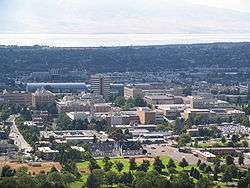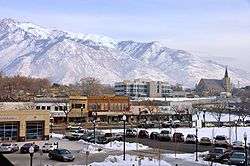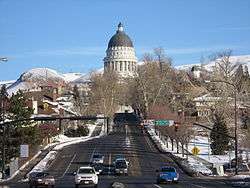Wasatch Front
| Wasatch Front | |
|---|---|
| region | |
|
| |
 Provo | |
 Downtown Ogden | |
| Country |
|
| Population | 2,156,027 |
The Wasatch Front /ˈwɑːsætʃ/ is a metropolitan region in the north-central part of the U.S. state of Utah. It consists of a chain of contiguous cities and towns stretched along the Wasatch Range from approximately Nephi in the south to Brigham City in the north. Roughly 80% of Utah's population resides in this region, which contains the major cities of Salt Lake City, Provo, West Valley City, West Jordan, Layton, and Ogden.
Geography
The Wasatch Front is long and narrow. To the east, the Wasatch Mountains rise abruptly several thousand feet above the valley floors, climbing to their highest elevation of 11,928 feet (3,620 m) at Mount Nebo (bordering Utah Valley). The area's western boundary is formed by Utah Lake in Utah County, the Oquirrh Mountains in Salt Lake County, and the Great Salt Lake in northwestern Salt Lake, Davis, Weber, and southeastern Box Elder counties. The combined population of the five Wasatch Front counties totals 2,125,322, according to the 2008 Census Estimate.[1]
Though most residents of the area live between Ogden and Provo (a distance of 80 miles or 128 km), which includes Salt Lake proper, the fullest built-out extent of the Wasatch Front is 120 miles (193 km) long and an average of 5 miles (8 km) wide. Along its length, the Wasatch Front never exceeds a width of approximately 18 miles (29 km) because of the natural barriers of lakes and mountains.
Population centers
| Rank (UT) |
Counties | Census 2010 |
Census 2000 |
Growth 2000s |
|---|---|---|---|---|
| 1 | Salt Lake | 1,124,197 | 898,387 | 0568+14.6% |
| 2 | Utah | 516,564 | 368,540 | 0617+40.2% |
| 3 | Davis | 295,332 | 238,994 | 0273+28.2% |
| 4 | Weber | 231,236 | 196,533 | 0273+17.7% |
| 8 | Box Elder | 49,975 | 42,745 | 0273+17.2% |
| Total | 2,217,304 | 1,745,199 | +22.27% | |


Several downtown and commercial districts encompass the Wasatch Front. The largest is Salt Lake City at the middle of the urban area. Utah Valley (south of the Salt Lake area) and the Ogden-Clearfield region (north of Salt Lake) are the other major population centers.
Nearly all of the cities within the region are connected by continuous suburban development. Cumulative population estimates of Brigham City, Weber County, Davis County, Salt Lake County, and Utah County for 2006 show that the Wasatch Front has an estimated population of 2,051,330 residents, or 80% of Utah's estimated 2007 population of 2,645,330 [2]
Transportation
Ogden has served as a major railway hub through much of its history. The First Transcontinental Railroad was constructed between 1863 and 1869, the tracks reaching Ogden on March 27, 1869. Trains heading east from Ogden must negotiate the highest reaches of eastern Utah, travelling through Weber and Echo Canyons and over the Wasatch Pass at an elevation of 6,792 feet.
Union Pacific has operated the world's most powerful locomotives to haul freight over the Wasatch Mountains between Cheyenne and Ogden, including ALCO's famous "Big Boys", the world's largest steam locomotive; GE's Gas Turbines known as the "Big Blows" (because of their distinctive sound), the world's most powerful internal combustion locomotive; and GM's "Big Jacks", the most powerful single-unit diesel locomotive type ever built.
Transportation issues within the metropolitan area have been complicated by the narrow north-south orientation of the valley, constrained by the natural barriers on both sides, and the rapid growth of the region.
The primary modes of transport for the area are Interstate 15 and U.S. Route 89, both of which run down its center from north to south for the full length of about 120 miles. Other interstates and highways provide transportation routes to local areas within the front. Such transportation routes include Interstate 84 in the Ogden area, Interstate 80 running east-west through Salt Lake, Interstate 215 circling the inner Salt Lake Valley, Bangerter Highway (State Route 154) and State Route 201 to the west of Salt Lake, U.S. Route 189 through Provo, and U.S. Route 6 in southern Utah County.[3]
The Utah Transit Authority provides bus and light rail (TRAX) service to most of the urban areas within the front. Additionally, a double-decker commuter rail line FrontRunner,[4] running from Ogden to Provo, and a portion of the Legacy Parkway project, connecting to I-15 & US 89 in Farmington and I-215 in Salt Lake City, are in full operation. [5] Other portions of Legacy Parkway and the Mountain View Corridor [6] are planned or under construction to accommodate passenger traffic between Ogden and Provo.
The California Zephyr of Amtrak[7] is the primary rail transport leading in and out of the Front, having a station in Salt Lake City and Provo.
Salt Lake City International Airport serves as the primary airport for the region.
Growth and land use

Because of the geographical barriers to the east and west, much of the land along the Wasatch Front has been developed. The region has experienced considerable growth since the 1950s, with its population increasing 308% from 492,374 to 2,051,330. Much of the remaining undeveloped land is rapidly being developed, and local governments have grappled with problems of urban sprawl and other land-use concerns.
The region on the other side of the Wasatch Range, including cities such as Park City, Morgan, Heber City, and Midway is sometimes referred to as the Wasatch Back and has recently shared in the rapid growth of the region.
See also
- 2003 Utah snowstorm
- Ogden-Clearfield metropolitan area
- Provo-Orem metropolitan area
- Salt Lake City metropolitan area
- Wasatch Back
- Wasatch Fault
| Wikimedia Commons has media related to Wasatch Front. |
References
Coordinates: 40°36′N 111°54′W / 40.6°N 111.9°W
